The Ostrich for the Defence (1912)
William Henry Hile
 “The
Ostrich is the Key to the future Development of all Mankind!”
“The
Ostrich is the Key to the future Development of all Mankind!”
In this meandering novel, a young American idealist pursues a
divine mission: to extract a flock of ostriches from a mystical utopian
village in Africa, bring them to Pennsylvania, and raise them under a
workers’ cooperative that will bring about world peace.
The book—ultimately an advertisement for an ill-fated business venture—is also a loose autohagiography of its author. William Hile indulged in the worst delusions of 19th century privileged Americans. He was a reckless colonialist, embolded by white entitlement and zealotry, and a narcissist whose greatest fault was his inability to perceive his own capacity for failure.
Structurally the book follows his own peripatetic life and career, and ends, abruptly, with the main character vindicated as a hero before any actual world peace is achieved. If the book is read on its own, one is left wondering where the promised utopia comes in. With the benefit of Hile’s biography, it’s clear the story is pure wish fulfillment. William Hile’s legacy is that of a quirky footnote to a long-ago fad, and a man who left a string of jilted investors and discarded animals in his wake.
Early life
William Henry Hile was born on October 10, 1869 in Mount Carmel, Pennsylvania. Both sides of his large family had been residents of central Pennsylvania since the early 18th century. He studied geology at Dickinson College, and married Margaret North in 1892. They had two children, William Henry Jr. (1893-1955), and Margaret (1900-1990). In 1894 the family moved to Alaska where Hile operated as an agent of J.P. Morgan. In 1897 Hile, his father, and other family members formed the Last Chance Gold Mining Company which operated in Alaska and California. Early returns from these ventures allowed Hile to travel extensively and develop his peculiar obsessions with social reform.
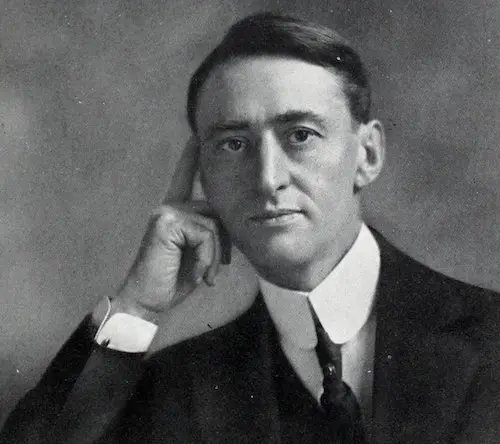
The ostrich economy
Decorative ostrich feathers were used frequently in 19th century fashion and were a common adornment for Civil War and other military uniforms, but the trend peaked in the early 1900s. The birds’ enormous wing feathers were indispensible in the oversized hats marketed to wealthy women in the period. Pound for pound they were said to be worth more than their weight in gold.
Ostrichs are desert animals native to northern Africa and its horn, but by the 1880s wild populations had been depleted. The global center for ostrich ranching was in South Africa, with smaller enterprises in the hot and arid regions of North America and Australia. By 1910 there were dozens of farms in the US, concentrated in southern California, Arizona, and Florida. Some were purely agricultural enterprises but many doubled as zoos or entertainment centers, each with their unique spin. (You can ride an ostrich, but they don’t much care for it.)
The ostrich farms of Edwin Cawston, established in Los Angeles in 1885, were among the showiest and most successful. Cawston was a young, far-seeing entrepreneur—he bought one of the world’s first commercial solar arrays to power his water pumps—and he was able to retire in material comfort in his 40s.



“Revolutionizing the Ostrich”
Though he lived for a time in Los Angeles, William Hile would also have encountered ostrich farming and potential business partners while on a geological survey in Arizona. In October, 1909 Hile and local Arizona speculators incorporated the African Ostrich Farm and Feather Company. Through his partners he acquired a few pairs of ostriches to start a pilot program, but the quantity available was far short of the number needed to fulfill his plans. And crucially, he’d need to find individual stockholders to supply his $1 million capitalization.
Hile had no access to desert real estate but his family connections in Pennsylvania put rural land in easy reach in cool, damp Bloomsburg. Though he believed it unnecessary, he boasted that proximity to the region’s coal could offset any heating costs. He found that the small number of birds in his pilot did survive the East Coast winter, and convinced himself that their feathers grew thicker and more luxurious in response to the climate.
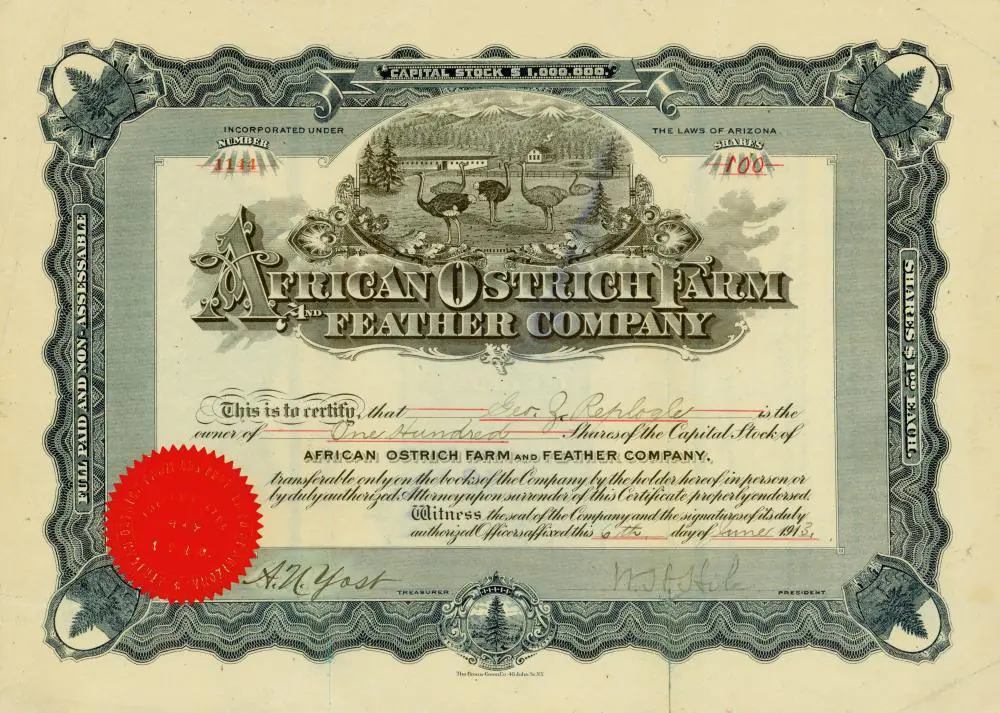
“The ostrich is the most valuable thing on earth”
No copy of the corporate prospectus exists, but aspects of it can be reconstructed from contemporary accounts:
It is impossible to value a good ostrich. For instance, what value would be placed on a breeding animal, which would produce an earning of one hundred dollars a year profit and an increase of five to twenty-five annually, which will themselves duplicate the work of the parent animals and will live for one hundred years. That is what an ostrich will do.
That is not, in fact, what an ostrich will do, though if it did it would seem quite easy to value it with simple math. Ostrich lifespans are closer to 40 years, they do not linearly produce more feathers each year, and they do not reproduce at any rate close to what the prospectus claimed. (“Presumably in course of time,” Munsey’s Magazine noted dryly, “the world is destined to be filled to overflowing with ostriches.”)
However, ostriches were money earners and Cawley’s California ranches had been profitable since the 1880s. The key risk in Hile’s venture was the mid-Atlantic climate, but he went further and sold investors on the notion that this desert animal would not just endure but flourish there:
No longer is he the frigate of the hot desert sands alone but a domesticated Americanized inhabitant of Pennsylvania’s coldest section, where he is furnished no artificial heat, permitted to roam at will in the snow and rain, thriving, and, by reason of the cold, producing the highest grade quality of feathers.
The great ostrich caper
In 1910, Hile traveled to Africa to—in no uncertain terms—steal his full stock of ostriches. By this point every country in Africa (or more accurately, their European occupiers) had protectionist laws against the export of ostrich eggs or live animals, so he saw no other option but to poach them. The Pittsburgh Post-Gazette called his expedition, approvingly, “an invasion.” The New York Times quoted him openly admitting that he lied to his scouts, telling them he intended to open the farm in Ethiopia rather than America. In his own account (using modern regional terms):
“I started my actual hunt from Djibouti, on the east gulf of the coast of Somaliland, being the only white man in the party. In all, I took fifty-four natives, and I was the only armed person in the party. For four months we stayed in the interior getting our birds.”
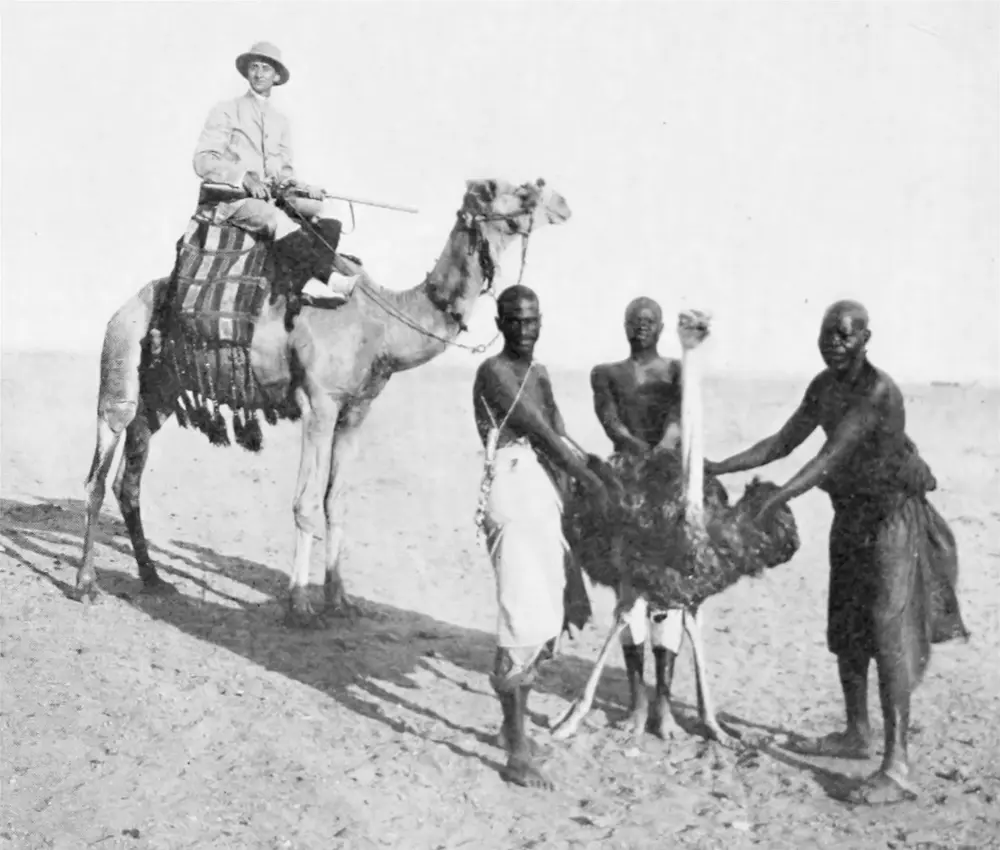
Hile took a filmographer with him and made this campaign into a documentary which he’d show on investor roadshows. The 1912 movie, “Growth of Practical Cooperation, as Seen on a Trip from Jerusalem and Egypt to Europe and America: The Story of the Ostrich Farm”, is lost, but Hile included still photographs from the venture in his novel—in which at least a second person is clearly seen holding a rifle.
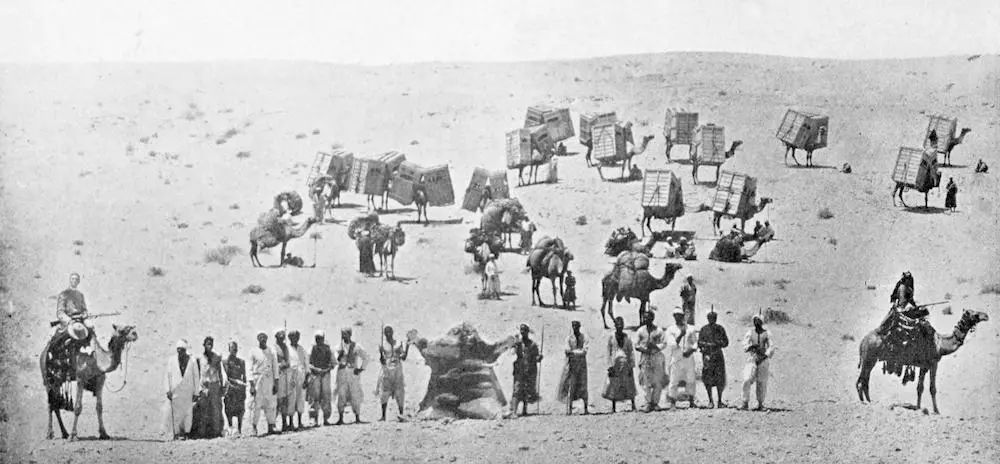
Hile seems to have absconded with 63 ostriches. On arrival in Boston 53 remained alive. There was a considerable delay in transporting them to rural Bloomsburg because not enough motor trucks existed in the region. It was initially claimed that 48 arrived alive on site and that four died shortly on arrival. Much later, the company would admit that only about 30 had actually made it to Bloomsburg, and that in the first few nights while the panicked animals attempted to escape, at least six broke their own legs and had to be put down, a sad pattern that would continue.
The 1912 novel
Virtually nothing is known about the circumstances surrounding the book other than Hile’s own preface. Published in 1912, it reflects incidents from his life up until the early days of the first farm, so it must have been completed early that same year.
The following pages have been written that those who read them may be both entertained and drawn closer to the increasing number of men and women who have found co-operation to be “The Lighted Way” to a true freedom of living.
These pages will, I trust, also serve to dispel the charge of being mysterious brought against me by some of my friends because of the silence which I have maintained concerning my frequent journeyings around the world.
Hile’s fictional doppelganger is Peter Stuyvesant Rutledge, a young New York idealist, who travels abroad to Europe. There he meets a beautiful prodigy, Ann Newman. During a concert performance she is possessed by a vision and declares, “The spirit now speaking to thee shows me a sacred scroll: The Ostrich is the Key to the future Development of all Mankind!”
Attendees find this behavior odd but accept it unconditionally. “The obligation is as binding as if the President of the United States had sent for me and put me under oath,” Peter Rutledge asserts. He immediately travels to Cairo in search of ostriches to buy for “the betterment of all mankind.”
The ostrich’s economic value is never discussed, though perhaps to contemporary audiences this was widely understood. Instead the novel tells that the ostrich has a long history of being venerated as the most sacred animal and a source of great political power. In Egypt he hears of a mysterious Queen Zar who has formed a perfect society in the Sahara. (She is white so when this plot point comes to the fore we know this will be problematic.) Peter is told she knows how to procure ostriches, but he decides to put a pin in the venture to return to New York in time for the Wall Street panic of 1907.
Peter’s friends in the city are cynical jerks who laugh about the riots and suicides that the panic has brought:
“I was on the floor of the stock exchange, yesterday afternoon, too, just before the gong struck for closing, when two guards and three others including myself, struggled for a full five minutes with Bill Atherton—‘Big Bill’ of the class of ’90, you know—before we got him handcuffed and tied up. The guards insisted on putting the twisters on him for fear he might do murder. He was stark mad—bit and clawed and laughed—I wonder if you ever heard a laugh like that—just as if everything inside had caved in and gone to smash.”
These conversations take place, somewhat incongruously, at the horse races on Long Island. The nearly impenetrable period slang is a high point of the book:
“Did you bury Bogey?” queried Peter, with mock gravity as he chose a seat beside Appleton, who had finally holed out and now sat sipping a rickey. The other grinned:
“The colonel has always had six on me, and hang it, the harder I try the worse duffer I get to be. It’s like trying to beat the game in the street.”
“I say, Sid, you hole out in Bogey there, every time,” put in Weston Morse. “I heard John Merriman tell Miller that, for a young ’un, you’d made a bunch of the bears look like croquet players at a pink tea.”
It is Ann who first suggests to Peter that a better world is possible, through the establishment of a network of cooperatively-owned businesses that will supplant the winner-takes-all status quo:
“The rich number eight hundred thousand—less than one per cent, of all the people in the country—yet this small fraction owns more than ninety per cent of all the wealth. Less than ten per cent is left for the rest. The wealth of a certain, single capitalist is said to equal the combined labor earnings of all the people for a year.
“Where is the man who does not wish to be his own master—to originate, to plan, to achieve of himself? Yet no longer is the pathway free for men to do this. The ranks of every trade and every profession are becoming more and more overcrowded. Marvellous machines perform the work which formerly engaged many men. Avenues of individual achievement are becoming fewer and fewer. Great aggregations of wealth now make it impossible for the man of limited means to undertake a business of his own with any hope of success.”
Hile had an ear for dialogue but no concept of structure or momentum. The novel stitches together vignettes drawn from Hile’s life of wealth and privilege, interleaved with proselytizing about poverty relief. Peter goes to Alaska with some chums, and in a long and tediously cruel sequence (an exaggerated retelling of a real-life hunting trip) they stalk and kill a pair of grizzly bears and steal the orphaned cubs. (The cubs are shipped to Peter’s sister as a gift, who understandably pawns them off on a zoo.) But then soon enough Peter is befriending a family in a tenement and holding their hands as they die one-by-one of tuberculosis.
Hile also used his novel as a vehicle for striking back at those who wronged or doubted him. In 1909 he and his wife were served with a fairly ordinary summons from a Seattle-area bank demanding repayment on a modest loan. The episode is sensationalized in the novel as an opportunity for Peter to insult a smirking Seattle banker with a “cold and clammy hand,” who boasts that banking cartels reaped enormous profits in response to the panic. “You deliberately robbed your own home people of their holdings!” Peter cries out. Hile would do much the same.
Peter then travels to South America, retracing Hile’s trip to Brazil as a representative of “a syndicate of US capitalists.” Peter is of course no member of Big Syndicate but instead is following a rumor about ostriches. He finds only “shiftless, half-caste” workers and that the local birds are merely emus. “Señor,” he sniffs to a Brazilian rancher, “your ostrich no longer interests me.” Apparently having forgotten about his divinely-inspired drive to alleviate poverty, Peter spends the next six months boar-hunting across the continent.
Eventually he reconnects with Ann in Italy. He tells her at great length about the horrific conditions of the poor in London and that he’s found inspiration in Britain’s cooperatively-owned businesses. “I shall go to Port Said and then on to find the mysterious queen of whom the sheik told me.”
Ann swoons. “You are going to solve the mystery of the ostrich?”
In Egypt, Peter explains to a government official that he intends to capture and export some ostriches, an act that they all agree is illegal. The official warns Peter that his lawless act of plunder may be threatened by “lawless Bedouins” who “plunder with great courage.” Peter is undeterred and insists that he has been invited by Queen Zar, and is allowed to proceed.
He tours her desert utopia and the prose takes pains to mention her white hands, white forehead, white robes, the white ribbons in her hair, even the white horses that pull her carriage. She sends him off with a small army to bring back wild ostriches. There are pages and pages of terrible racist scenes that are not worth repeating, but Peter gets his birds.
Queen Zar, having apparently read the prospectus, gives him some parting advice:
Thou hast no doubt already learned, if thou hast studied the ostrich, that the bird lives a hundred years, and that, contrary to the rule with so many animals, no ailment or plague affects it. But more than all this—and thou, my brother, art the first dwelling in the outside world to learn this secret—the ostrich will thrive even better in a climate of extreme cold than it does in the tropical wilds. Thou art to convey a great flock of these birds to thine own land where the truth of this secret shall be proven for all.
She goes on to add that once “Peter” has enough shareholders, the great monopolies of the Gilded Age will merge into a giant nationalized cooperative, that all wars will cease and everyone will speak a universal language, and that poverty will be abolished.
The novel concludes with a rally where Peter addresses a crowd of “enthusiastic and happy workers” who have joined his cooperative. Everyone who ever doubted “Peter” comes to tell him that they were wrong: “Max Reinhart, once so skeptical of Peter’s ideas, was now overwhelmed at the magnitude of these results. He knew at once that Peter had learned the great secret of bettering humanity.” Ann of course, agrees to marry him, because of his “unswerving loyalty to the spirit of the Call of the Ages.”
“The ostriches that we own will go on increasing,” Peter promises his working-class investors. “Our incomes will go on increasing. Our success will go on increasing.”
“Failure was impossible.”
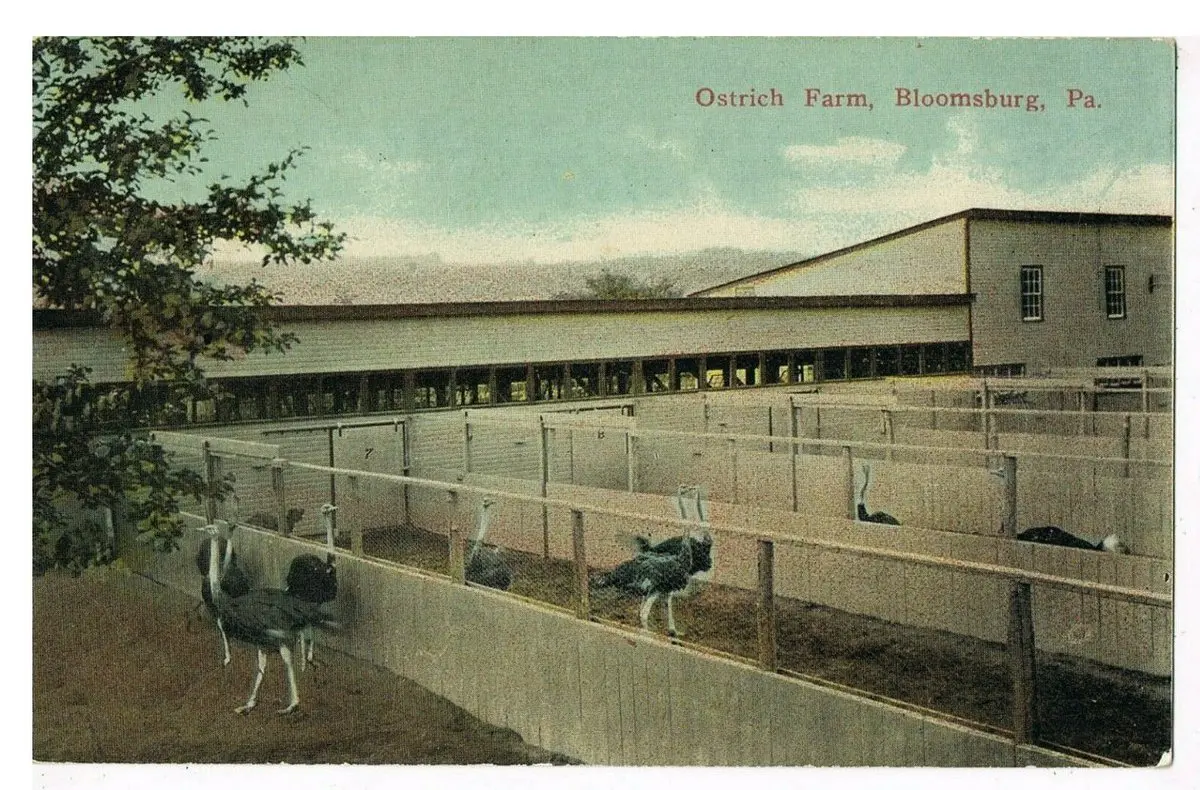
The original Bloomsburg location was an aggregation of three farms, plus office space in the city and a facility to process and dye feathers. Optimistic about demand, the company installed three phone lines, an expenditure noteworthy enough at the time that Bell Telephone gave Hile pages of free and fawning publicity in return.
In addition to the ostriches, the corporation purchased expensive Guernsey cattle and other exotic farm animals. Thankfully Hile did not follow through on his scheme to travel to Alaska in 1912, purchase 200 seals, and stick them in a pond on the farm.
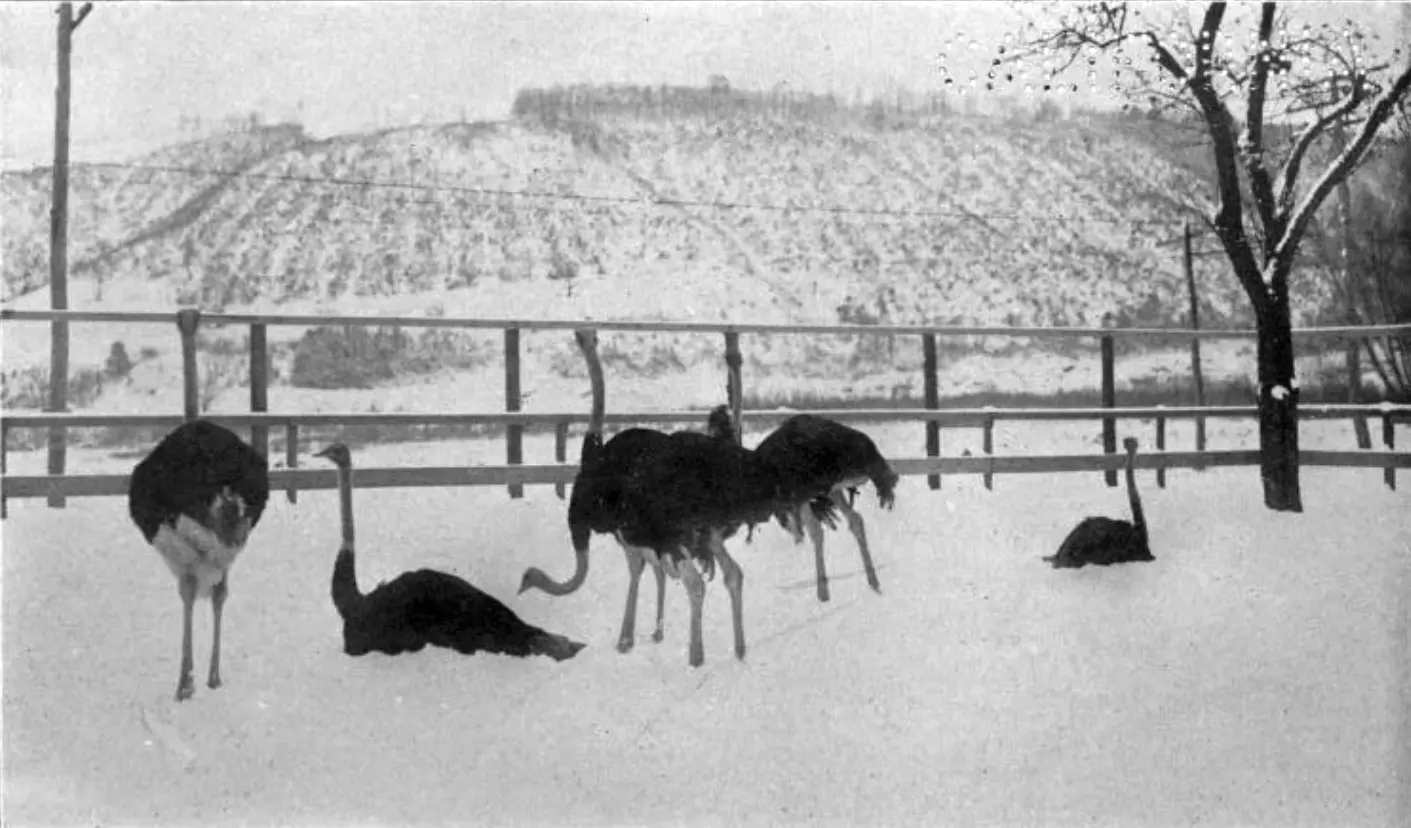
In the period between 1912 and 1913 it probably seemed like things were going well. British textile workers who had immigrated to the area enthusiastically invested in the scheme because they were familiar with English-style cooperatives. Hile himself frequently shared the company’s progress with shareholders (or at least, his version of it) and they seemed happy enough to sell more shares via word-of-mouth. Local press followed the farm’s progress at every step: in 1911 when the ostrich “Roosevelt” lost an eye to another bird; the first ostrich omelet in 1912; an attempted “murder” by an angry ostrich in December 1915.
In November 1913 Hile was already seeking to open a second and more centrally-located farm in Harrisburg, and a month later had purchased land in Virginia for the same purpose. The feather-processing plant at the original location was relocated to Harrisburg. A limestone quarry at Bloomsburg, intended to be a key revenue stream, had still not been built by the time of the February 1913 shareholder meeting.

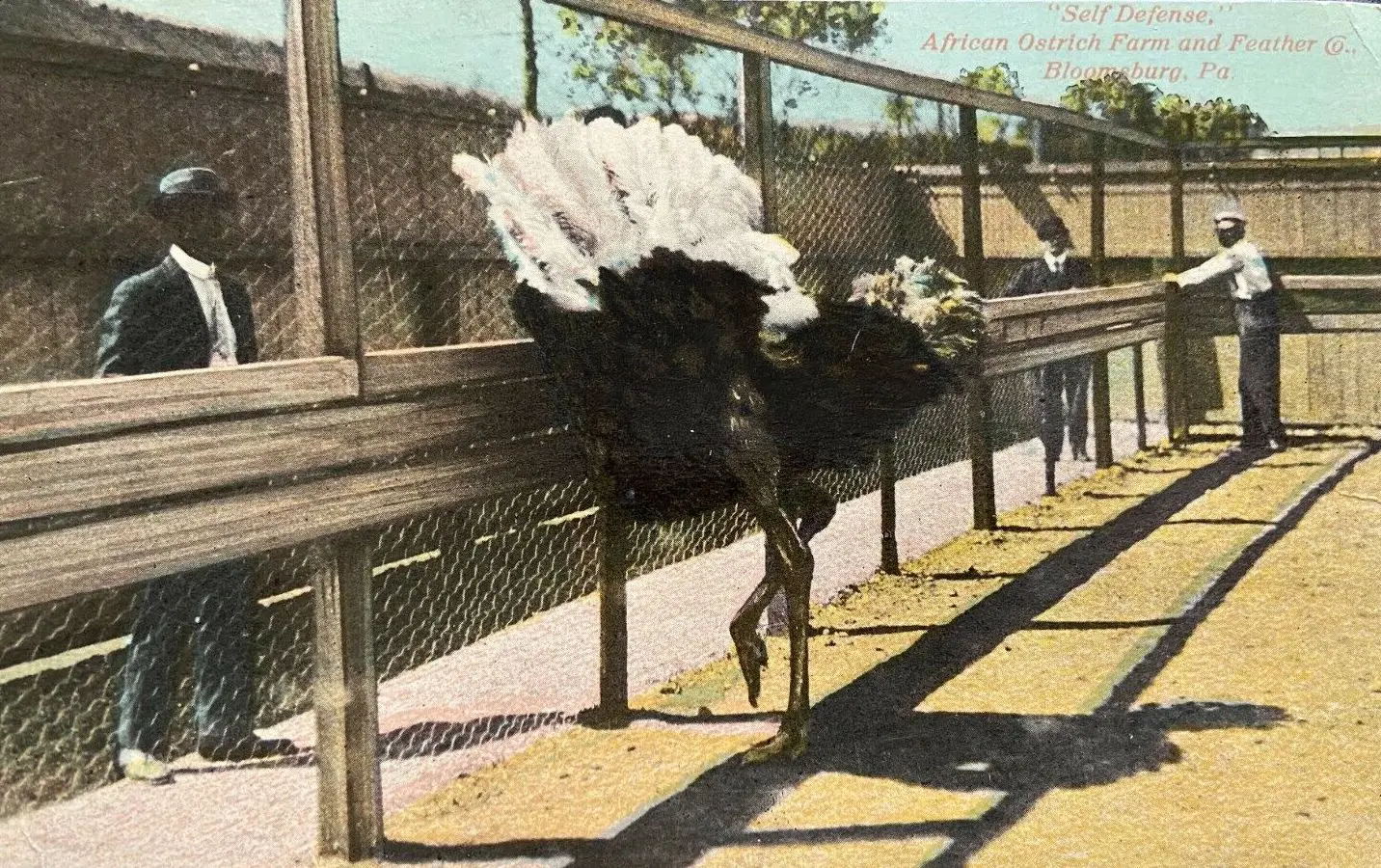
The farm wasn’t generating any revenue of any kind. Hile refused to harvest the feathers of his ostriches because they were still “acclimating”, so the company had been quietly buying feathers from its sister farms in Arizona and processing them in Pennsylvania. Even before the international feather market collapsed in 1914, this side of the business was not profitable. And though they weren’t providing feathers, the ostriches still needed to be fed, over 60 pounds of specialty feed per month per animal.
Worse, the ostriches weren’t making more ostriches. It wasn’t until July 1914—two and a half years into the venture—that even one chick hatched at the farm. The company made the best of it for a time, using the unhatched eggs as promotional fare, and attributed the delay to the young age of the ostriches. But nobody on the farm knew how to care for the eggs, and Hile’s insistence that the birds were hardy was simply false—even modern ostrich ranchers complain “the stupid birds just go looking for things to die of.” We know today that Hile’s flock contained two distinct species; as a result the farm wasted valuable time trying to crossbreed them. In the first three years only two eggs ever hatched; the first chick died almost immediately, and the other within two weeks, “from chewing a piece of cloth.”
As time went on Hile’s claims became even more divorced from reality. He first asserted that ostriches, which live for about 40 years, easily reached 100 years old. By 1913 he was telling credulous listeners the figure was more like 150. In 1914, his ostriches would be living to be 200.
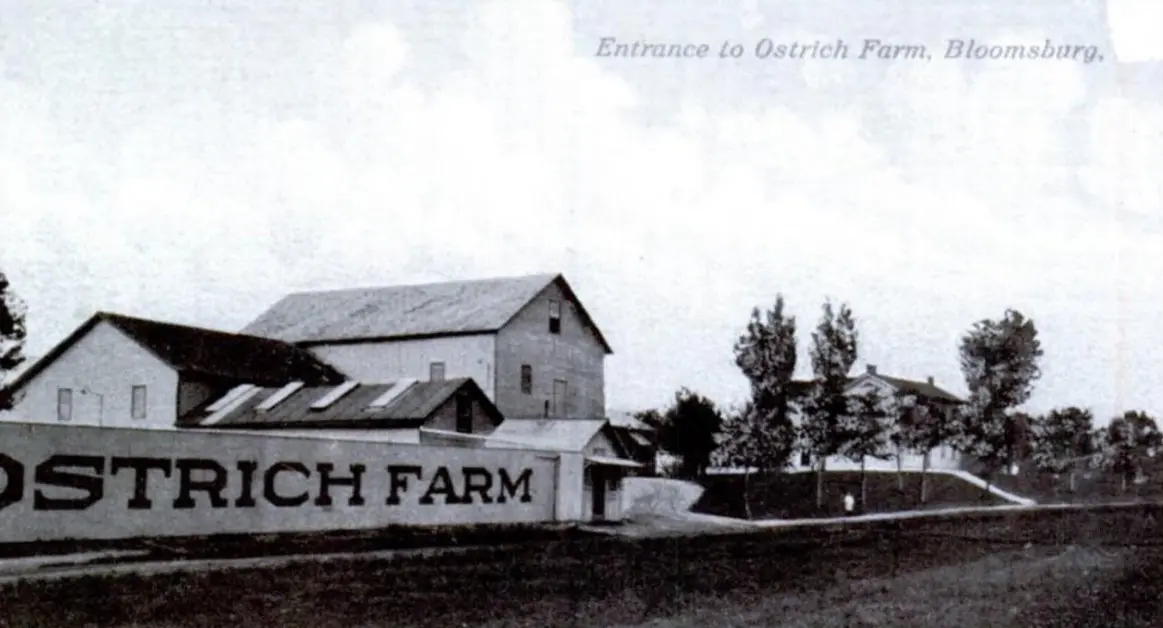
In December 1913 everything started to unravel. A group of activist investors in neighboring Wilkes-Barre began to publicly raise concerns about a lack of financial transparency. One prospective stockholder accused the company of clipping off fake feathers in demonstrations. In a page one story in the Harrisburg Telegraph, Hile’s personal secretary made a statement to shareholders, blaming malcontents “who are complaining because we have not been able to pay a dividend as we promised”—a reasonable thing for investors to complain about! One item of contention was the direct distribution of stock to directors, including Hile, as a form of compensation—a common practice today but very much at odds with the cooperative model.
Hile himself was not in attendance when the revolt went public—he was attempting to woo a Cleveland park owner—but he rushed to Harrisburg to respond with a prepared statement comically headlined, “Ostrich Company Head Interviews Self.” Corporate vice-president and state representative George William Oster wrote a letter to the Altoona Tribune accusing one investor of poisoning the entire “Nest of Ostriches” in Wilkes-Barre, warning “all loafers, gossipers, scandal mongers or other mischief makers” against further slandering the enterprise. “No company ever existed anywhere whose books and records were more correctly or accurately kept than those of the Ostrich company.” Under oath this would be revealed to be a falsehood.
Hile may have hoped economies of scale would save the venture. At the February 1914 shareholders meeting he projected ten more farms would be opened in the coming year. In September 1914 a group of investors in Altoona enthusiastically voted to establish a distribution center in the area, and plans were being explored in Pittsburgh and Rochester to allow supplies to be bought in bulk at wholesale prices. In November 1914 a new farm opened to the public in Paxtang, outside of Harrisburg.
The buying spree ended in 1915, when the African Ostrich Farm and Feather Company ran out of cash.
“I have been deserted and we are in trouble.”
At the bankrupcy hearings in July 1915, Hile asserted that he had been naive and a victim of a short-sighted board. He had never undertaken an external audit of the business, saying he’d wanted to do it all on his own. Though the business was cash poor, he’d blocked the board from collecting on investors who’d bought stocks by subscription (rather than up-front cash), arguing that individuals who’d invested on credit were economically disadvantaged. “I was attempting to create an organization that would do something worthwhile,” he said.
Though the core income stream had been deferred while waiting for the ostriches to “acclimate,” Hile criticized his board for their attempts to diversify into hogs, horses, and mining—“they let the business go to hell.” Though it was Hile who had pushed their relentless expansion into other regions—and he was the one who wanted to import Alaskan seals!—he had convinced himself that it was only the ostriches that mattered.
He testified that he still believed in the business and that he welcomed putting it into receivership to get it out of the hands of the board. The ostriches at Bloomsburg, now in their fourth year at the farm, were “approaching their productivity stage” (a claim he’d been making for years) and were the progeny of highly fertile parents. They just needed more time, and, he added, a return to the “normal condition of the feather market.”
The prosecuting attorney asked if that would be enough to make the business profitable:
“With a live, competent business man selling our product, we can get control of the feather business in the United States.”
“Are you a live, competent business man?”
“I am not a feather merchant,” said Hile quietly.
In August 1915 a judge ordered the sale of all real assets, starting with the 35 remaining birds and the three original Bloomsburg farms, to cover the outstanding debts, but cautioned that in all likelihood “the stockholders will never get back one cent of their investment.” In November 1915 a small group of original investors purchased these assets and reorganized the company, with Hile no longer in control.
“The ostriches are doing fine”
In 1916 things looked like they might actually turn around. Without Hile committed to proving their cold-hardiness, a comprehensive system of egg incubators were installed and by June there were 17 live chicks (the first two named “Wilkes” and “Barre” after the activists). By mid-1917 the reincorporated venture was anticipating profitability by the end of the year. Most of the previous year’s hatchlings had survived and more than 80 eggs were being incubated.
But the ostrich feather fad had passed, due to changing fashions and trade disruptions from World War I, and the birds still needed to eat. In April 1918, after a suit by remaining creditors, all assets were sold at sheriff’s auction. There simply wasn’t enough money in the business itself to cover the outstanding debts.
Hile appeared at the auction and, desperate to prop up the value of ostriches, bought a pair for the hugely overvalued price of $2,000, but no other bidders followed suit and the remaining 10 animals were sold for only $25 each. A single caretaker was put in charge of the ranch but there were insufficient funds to feed and tend the flock, and by December of 1918 many of the birds had died and the rest were dangerously underweight. As an emergency measure they were put under the care of the Society for the Prevention of Cruelty to Animals, who recommended that many of the suffering birds be euthanized and sold as meat.
The last birds of Bloomsburg
Newspapers loved to report on the fate of the so-called “last bird”—if you believed the stories the same “last” animal was eaten by the firefighters as a fundraising stunt, by chocolate magnate M. S. Hershey, and by a local hotelier who served it to other former investors. It’s unclear, and unimportant, in which order they were actually dispatched.
But incredibly, six ostriches were rescued. In 1919 the SPCA reached an agreement with the New York Zoological Society to transport the healthiest animals to the Bronx Zoo Yak House. The zoo, which did not need additional ostriches and took them in purely as a humanitarian gesture, wrote in their newsletter, “The fine ostriches are happy and contented, their daily rations assured.”
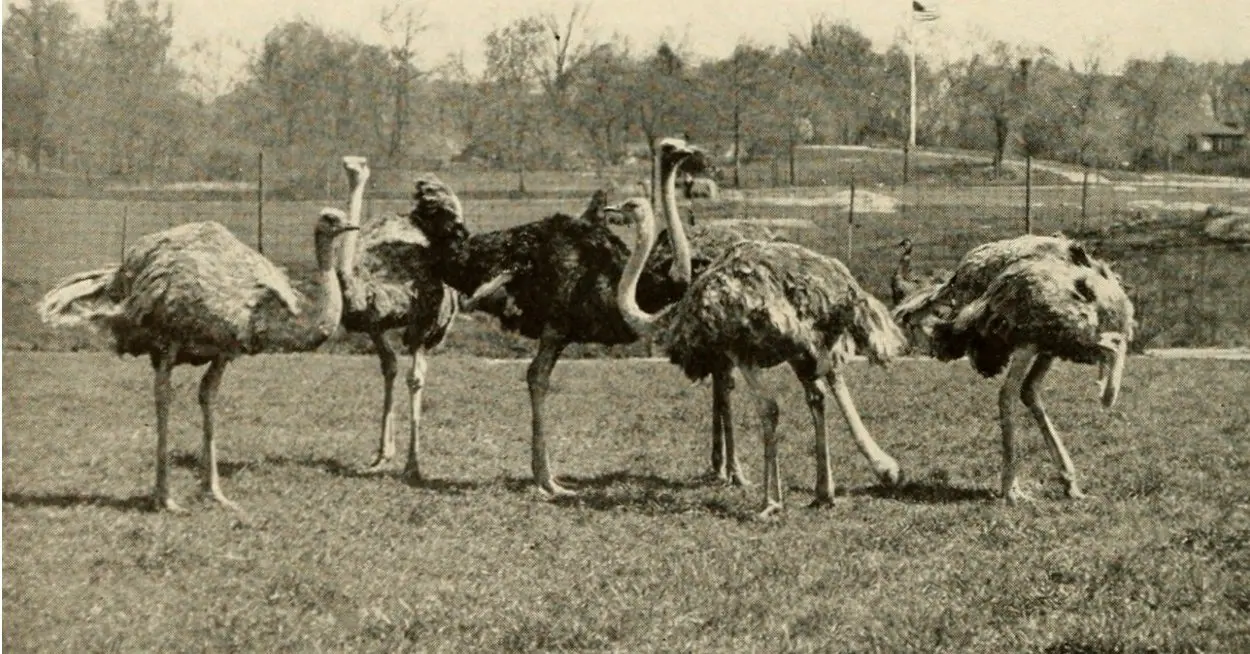
Hile in obscurity
William Hile retreated to Wyoming for a time, but returned to the East Coast sporadically to drum up interest in new ventures. In 1916 he attempted to enlist former Bloomsburg investors in a scheme to raise ostriches on a ranch in Wyoming under the auspices of the “Alta Vista Land and Cattle Company.” He told attendees he would “break their heads” if they revealed details of his proposal to outsiders. That this was promptly reported in a newspaper and that the cattle company appears to have never been formed suggests that this bizarre tactic was not persuasive.
In 1918 he was actively touting a method to extract oil from shale as president of the National Oil Machinery Corporation, which used investor money to buy 20,000 acres of Colorado shale land. This venture too suffered from hopelessly poor timing, as the shale oil business would collapse in the 1920s when easily-extractable crude oil deposits were discovered in Texas and the Middle East.
Hile’s early writing had streaks of anti-Semitism throughout, which tended to surface in his references to banks but extended to his treatment of Jewish people he encountered in the Middle East. As he got older this tendency deepened; in 1922 he was a founding member of the “Henry Ford for President” club (tagline: “He’s a sociologist, not a socialist!”) and Hile’s obituary would note how much he admired the writings of American fascist priest Charles Coughlin.
Sometime before 1930 his marriage had collapsed, and Hile’s long-time business partner James Teple died unexpectedly in 1918. In 1929 William Hile, then 61, married Teple’s widow, Helen Masteller, then 40. The pair lived with her three teenage children in a modest rented home in Toledo, Ohio, and he would die there of a heart attack at 65.
Hile’s heavily fictionalized obituary made no mention of his business ventures or farms, noting only that he captured a shipment of ostriches as part of his “colorful” world travels. His autobiographical novel is described as a dry survey of economic principles. His family even stripped the word “Ostrich” from the title—it’s just “For the Defense.”

References and further exploration
The Ostrich for the Defence (1912) full text and facsimile
“When Bloomsburg Had An Ostrich Farm”, includes additional ephemera from the farm
The second (and third) American ostrich boom in modern Texas